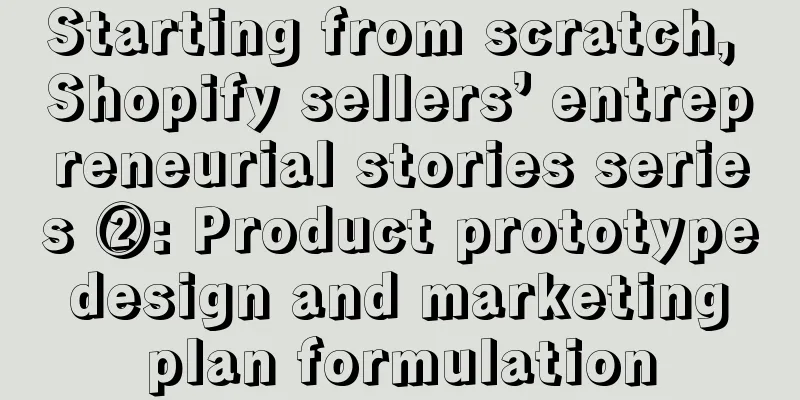Starting from scratch, Shopify sellers’ entrepreneurial stories series ②: Product prototype design and marketing plan formulation

|
Sellers, do you want to know what you need to do to create an e-commerce business from scratch and open a Shopify store? Next, we will use a series of articles to present the steps taken by Shopify seller Tim Kock to achieve his goal of $1,000 profit in 8 weeks, and how he approached his small goal step by step. The previous article talked about how Tim priced his products, how much start-up capital he had, and how to find his target audience in two weeks to achieve a profit of $1,000 in 8 weeks. So what did Tim do in the third and fourth weeks? The first article (click here to view) mentioned that Tim wanted to sell hand-painted, or more precisely, hand-sprayed backpacks. Here is the process of Tim designing a product prototype: First, Tim tested the backpack with color sprays to figure out which color spray would be best for the product. Tim conducted five tests:
He bought two different types of spray color and printed and cut out the word "HYKE" to test it. Although it looks like a mess and is far from a finished product, the entire testing process was worth it. During this process, Tim encountered some problems and found ways to solve them. For example, he initially planned to spray the letters on the back of the backpack, but that didn't work out very well. So he decided to spray the letters on the shoulder straps instead, and that worked well. Also, one spray wasn't waterproof, even though the product said it was. At the end of the testing, he had solid results and better insights into how to make actual products for consumers in the future. In addition to doing the test on the backpack, he also did another test, the packaging test. Obviously, e-commerce sellers have to ship. Therefore, finding the right product packaging cannot be ignored. Let's take a look at how Tim found the right product packaging: First, he found some cardboard and tape. Before placing a sample order of 100, he bought a box at a local post office and tried their standard sizes. Since buying these cardboard packaging and tapes one by one at the local post office is quite expensive ($2.82/each), he searched on Google for the best affordable packaging material supplier. (Search bar keyword English translation: packaging material): After about 10 minutes he found a good package: 75 packages for 35.25 euros (about $0.53 per package), which was a good deal for him compared to the price at the local post office ($2.82 per package). One of the main features of Tim's products is that they have a strong personal style, and each backpack is unique. Therefore, if he puts the "HYKE" logo on the product package, customers can immediately know who sent the package. Buying custom packaging was expensive, even custom tape was expensive. So he thought why not make it himself? He sprayed the logo on the package, and it became like this: But this is not enough for packaging! He also wants a dust bag for the backpack. This product project has a small budget, and the customer's unboxing experience should be the best possible. Tim sells each backpack for $99.99, so customers should be satisfied with the product service. However, he has yet to find a good supplier of dust bags that are of the same quality and fit the size of his backpack (49cm x 38cm). But overall, product packaging is moving in a good direction! So far everything seemed to be going well and Tim hadn't run into any major troubles. The previous story mentioned that Tim made a business partner, who was the founder of a sports shoe startup in his hometown and now a 3D artist. When Tim first saw his logo, he thought it would look better in 3D. But it was hard for him to imagine what it would look like in 3D. Since he didn’t have 3D animation software on his personal computer and didn’t want to spend time learning new software, he asked a friend if he could help. Luckily, his friend agreed. He explained the animation effect he wanted to his friend face to face. In the end, Tim only spent 80 euros (about 90 US dollars) and got a beautiful 3D animated logo. The reason why he wanted this 3D animated logo was simple: having a beautiful 3D animated logo would help his marketing. So far, Tim has not done any marketing, all he has done is build the foundation for his new business. But as the market becomes more competitive, it is time for Tim to consider some marketing options. Any marketing plan he created should be aligned with the SMART goal he set (i.e. $1,000 in profit in 8 weeks). In fact, he took a step back and broke the goal down into more actionable steps. The first step he took was to understand how much traffic he would need to achieve his goal. Based on the latest quarterly e-commerce benchmark report from Monetate (a software company that provides e-commerce solutions to online retailers) , the average conversion rate for the e-commerce industry was 3%. He did the math: Remember the result of Tim's calculation of break-even in the previous article? He needs to sell 44 backpacks at a price of $99.99 (or 79 at a 30% discount). However, his goal is not only to break even, but to make a profit of $1,000. So he needs to sell more backpacks. If his profit per backpack is $53.89, he needs to sell 19 more, for a total of 63. This means he needs to drive 2,100 visits to his website. In addition, since he plans to spend 5 weeks marketing his store, his daily traffic goal is 60 visitors. *In this 8-week case study project, there are only 5 weeks left for marketing. If the business is going well, he will continue marketing. Achieving these numbers may seem difficult. The next step was to figure out where he was getting his traffic from. He created another Google spreadsheet and entered all the traffic sources and potential traffic sources he could think of. He divided traffic sources into 3 categories:
As shown in the above figure, Tim's potential traffic from all sources is 5375, which is more than 2.5 times the required traffic. When he was worried about the source of traffic, he was very happy to see this data. Even if the conversion rate will drop, many people will buy with the discount price, or anything beyond his calculation will happen, he still has a great chance to achieve his goal. This spreadsheet is not only used for traffic calculations, it also serves as his marketing to-do list. He can clearly see what he must do to achieve his goals. If he is busy and can only focus on one marketing campaign, he can know which source will bring the most traffic. Overall, these calculations are good news for Tim. He’s ready to start marketing, but he doesn’t even have a website, so where can he direct traffic? That’s why he’s going to open a store on Shopify! After designing the product prototype, packaging, and calculating the data, Tim gradually felt a little nervous. Because the product has not been shipped for 10 days after purchasing the backpack. Additionally, the tracking code provided by the supplier appears to be incorrect. Here are the results when Tim checked DPD (international parcel delivery service), showing that his package could not be found: Fortunately, the supplier was able to respond in time and seemed to be very worried. However, the logistics were too long and Tim's business process became very slow. This also ruined his 5-week marketing plan. Tim had been preparing for this business for 4 weeks, but he hadn't even started marketing yet. Moreover, since HYKE's business concept is to sell hand-sprayed backpacks, Tim must let potential customers see the product. However, he only has the original product pictures he made, which is far from enough to use for product pictures. Summary : Tim can’t start promoting the product yet because he can’t show people what the product looks like. This means that once he receives the product, he will have to work harder to market it in order to achieve his goal. To prepare, Tim asked himself, “If you only had two weeks left to market, what would you do?” The first thing he thought of was to adjust the flow meter, which he did: If other data remain unchanged, Tim needs to increase the traffic to the website by at least two times, that is, the original plan to introduce 60 visits per day must be adjusted to 150 visits. The adjusted plan is still achievable. In order to better obtain traffic sources, Tim also adjusted the traffic source table. Tim felt that adjusting the number of Instagram comments was the most practical, so he made a huge change: from 50 comments to 75 comments. In fact, Tim only needs to leave 25 more comments on Instagram per day. *Note: These data are only the data to be achieved in order to achieve the marketing goal under the most undesirable circumstances. After adjusting the traffic table and traffic source table, Tim is no longer nervous about the delayed delivery, and is even a little happy. Because the problem of delayed product delivery can not only be solved, but it may be better if the product can arrive earlier. Summary: It is normal to encounter problems when doing business. If you cannot directly control the problem, control your emotions first, and then find ways to control the problem (it is also OK to solve the problem indirectly). Tim originally planned to open the store in week 4 and start selling backpacks. Due to logistical delays, Tim had to change this plan. Just sitting and waiting wasn't Tim's style, so he set out to start collecting email addresses. To collect email addresses, you first need to set up a website. Even though you haven’t officially started selling yet, you should still sign up for Shopify to temporarily collect email addresses and build an email list. People don’t usually give out their email addresses easily, so give them something in return. In the second article, Tim has narrowed down his audience and found the best solution, which is content marketing. Tim chose content marketing simply because it was the best marketing method for his business. His business philosophy and the type of audience he was targeting were completely personal preferences, so for consistency, content marketing was the best fit. Content marketing topics should at least be more or less related to backpacks. This will bring targeted traffic to the site, which is more likely to convert into sales. Since there was no suitable topic, Tim chose the broad topic of entrepreneurship and put it under the popular children's game "I packed my bag". This can also become a cool email series. To collect email addresses, Tim downloaded Shopify. He then designed the landing page for the website: He set the login page to "Instant Landing Page" so that when customers enter the website, they will stay on the registration page. This setting can prevent customers from skipping the registration and entering the website directly. In order to start collecting email addresses and get the business going, he contacted everyone in his network who was interested in the topic of entrepreneurship. As shown below: Just like that, Tim got his first subscriber. In addition, Tim also asked them to share it with 1-2 friends who might buy the product. *Note : He set up his welcome page at the end of week 4. On that day, there were only three people on the email list. As he drove traffic to his site from other marketing channels, the number of people on the mailing list grew. While waiting for the product to be launched, he also launched his own social media accounts. He chose Instagram, Facebook, and Twitter because these are the main platforms where his target audience socializes. At the same time, since he is his best target audience, he thought of his three favorite social media. 1) Instagram Tim sets his Instagram homepage to be simple, rather than a marketing account that posts product advertisements all the time. Therefore, his Instagram homepage content mainly includes the following four aspects:
In the second week, when he was looking for his target audience, he found that he was the target audience type. Therefore, it was easy for him to come up with copy because he knew what kind of content he liked. Here is Tim’s Instagram profile: And the 6 published contents: Maybe his Instagram style isn’t the most perfect, but for a seller who’s just starting out, it’s okay. 2) Facebook He uses Facebook for three main reasons:
Among them, Facebook groups are likely to be of great help. He thought of using Facebook:
Since he doesn't have an audience yet, it seems better to create a Facebook group, which can attract more people by creating a group on a specific topic. He created the HYKE store on Facebook mainly because he could connect his Instagram to his Facebook page, share posts directly from Instagram to Facebook, and link to his Facebook group. 3) Twitter It is also possible to link your page to Twitter. First, he created the following page and set up a sign-up option to send people to the landing page. But he hadn’t published anything yet. Just like Instagram and Facebook, he wanted to set up the page first and maintain the account in preparation for marketing. He wants to use Twitter marketing strategies in two ways:
It only takes about 15-20 minutes to open Instagram, Facebook and Twitter. At the moment, he’s not selling anything yet. In the run-up to marketing on social platforms, he’s just trying to reach as many audiences as possible and build an email list. It is normal to encounter some problems in the course of doing business. You must first control your emotions, don't be discouraged, and try to solve the problems. Next article preview: Tim is about to open a store on Shopify. How did he make his first pot of gold? Let's wait and see Text✎ Zhu Meiying/ Statement: When reprinting this article, the title and original text must not be modified, and the source and original link must be retained. |
<<: Cross-border e-commerce tools inventory: 22 best free video editors
>>: E-commerce sellers must know! 12 statistics about Facebook advertising and marketing in 2019
Recommend
Big news! Something big is going to happen in the cross-border circle, and sellers can’t sit still!
2021 is destined to be an extraordinary year. Cros...
Amazon's major welfare plan helps cross-border sellers to sell well during the peak season
In order to help sellers make adequate preparation...
What should I do if my account is blocked by Amazon due to repeated violations?
text Account security has always been the top pri...
What is HTS coding? HTS coding review
HTS is the abbreviation of Harmonized Tariff Sched...
Product selection sharing: These ten home furnishing products are very popular
For cross-border e-commerce sellers, the quality ...
The top 10 most downloaded apps in the United States in 2021 are revealed! TikTok ranks first!
According to reports, eMarkerter has released a li...
What is WorldFirst? WorldFirst Review
Since its establishment in London, UK in 2004, Wor...
How much do you know about Amazon off-site traffic?
Amazon mainly acquires customers through on-site t...
What is Iconosquare? Iconosquare Review
IconoSquare is a powerful Instagram and Facebook a...
Amazon operations suddenly suffered a disguised pay cut! Are sellers "threatened" to leave the company?
▶ Video account attention cross-border navigation ...
In 2021, how to break through the siege and seize the initiative?
I have just finished the main work of the fourth ...
What is TÜV certification? TÜV certification review
The TÜV mark is a safety certification mark specia...
UPS to process more than 60 million return packages during peak season, up 10% year-on-year
<span data-shimo-docs="[[20,"获悉,据外媒报道,随着美国...
FBA pilot new function! Ranking traffic is not affected by out-of-stock
How much impact does out-of-stock have on product...
What is VK? VK Review
VK.com (formerly VKontakte.ru, referred to as VK) ...









